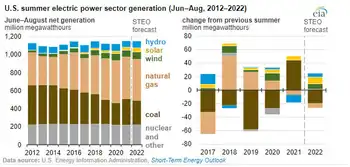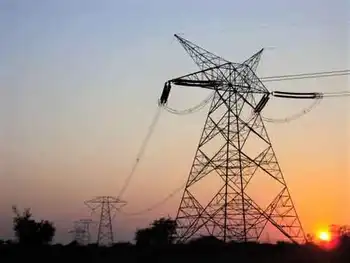Livestock manure a lost source of energy
By Toronto Star
Protective Relay Training - Basic
Our customized live online or in‑person group training can be delivered to your staff at your location.

- Live Online
- 12 hours Instructor-led
- Group Training Available
That's enough poop to produce as much electricity annually as a small coal-fired generating station, like two plants currently operating in northwestern Ontario.
As the Europeans have been proving for years, manure can be turned into electricity. Farmers across Europe use anaerobic digestion technologies that operate much like our own stomachs. Throw in a dash of micro-organisms and the systems, first developed back in the 1930s, break down dung to produce clean-burning methane gas and heat. The gas can be burned to produce power for the farm or for sale into the grid.
In Germany alone there are more than 3,700 of these systems in operation, producing about 800 megawatts – enough to power 400,000 homes, according to the Ontario Large Herd Operators Group. A recent study from the University of Texas at Austin found that manure could satisfy nearly 3 per cent of electricity demand in the U.S. Extrapolating for Canada, the figure is slightly higher.
"It holds incredible potential and the Europeans are demonstrating it," says Nils Semmler, founder of Peterborough-based Renewable Energy Technologies Inc., a supplier of on-farm digester systems. "There's tremendous demand out there for it, and it's a perfect replacement for coal."
In Ontario, however, the number of operational on-farm digestion systems can be counted on one hand, despite a two-year-old provincial program that pays a premium of 11 cents for every kilowatt-hour of poop power produced.
"It appears to be more of a bureaucratic rather than technology problem," Semmler says.
Others agree. "The red tape is just unbelievable," says Paul Klaesi, owner of a dairy farm about five hours northeast of Toronto that has about 300 cows. Klaesi, inspired by his Swiss roots, decided in 2003 to put a 50-kilowatt digester system. It's one of three operating in the province that together produce less than half a megawatt.
"When we started everybody said it wouldn't work. But we did it, and paid for it on our own," says Klaesi, adding that it took a lot of money, time and energy that most farmers simply can't spare.
For example, he's in the process of expanding the system but has been waiting about 18 months for Hydro One to connect it to the grid. It's not just the $150,000 he had to pay to have a 1.5 kilometre distribution line brought to his property, a cost that in Germany would have been picked up by the government.
"The problem is that you have to deal with so many people in different departments of Hydro One to get that connection," he says.
It baffles Klaesi that Queen's Park and its various agencies and Crown corporations don't appear eager to make it easier.
Proponents of the technology point that there is a reliable flow of manure, allowing farms to produce electricity when the province needs it, much like a coal or natural gas plant. This contrasts with wind and solar power, which are difficult to predict. And unlike wind, digester systems also produce heat that can be used directly on the farm to displace boiler oil or propane.
Digester systems also keep manure from decomposing in the field and releasing methane into the atmosphere. Methane is 21 times more potent a greenhouse gas than carbon dioxide. This means it's better to burn the methane, release CO2, and in the process displace coal-fired power generation.
Anaerobic digestion of the poop also neutralizes pathogens, such as E. coli, that can end up in rivers, lakes and drinking water.
"I think about Walkerton," says Martin Lensink, general manager of digester supplier PlanET Biogas Solutions in St. Catharines. "There was manure that had E. coli in it that went into the water system. We could have treated that."
Despite these advantages, electricity from manure still fetches the same price for electricity that comes from wind. Solar gets 42 cents per kilowatt-hour, nearly four times as much. Farmers want to put digester systems in, says Lensink, but 11 cents just doesn't justify the high upfront costs. They want the rate increased to between 13 cents and 19 cents, depending on the size of the system being proposed.
"For rural Ontario this is such a big deal. Farmers need another source of income, and from a sustainability perspective, turning the farm into a power plant makes sense," Lensink says.
The Ontario Power Authority, the agency in charge of the power purchase program, says it understands farmers' concerns. It will launch a program review later this year and hopes to address many of the issues holding projects back. It is also in the process of reworking rules for all small-scale renewable projects with an aim to speeding up the queue and removing red tape.
"Our intention is to resolve it by the end of the year," says agency spokesman Tim Taylor. "Price is something that will be dealt with... but there are no guarantees on where the price will go."
Taylor says farmers can already get an additional 3.52 cents per kilowatt-hour if they can demonstrate their systems can deliver electricity when demand on the grid is highest. But farmers say that averages out to only 11.7 cents over a 24-hour period and doesn't price in the advantages that farm-based digesters have over wind, solar and hydro-electric projects.
Sensing farmers' frustration, some companies are seeing a business opportunity by positioning themselves in the middle.
Toronto-based StormFisher Biogas has plans to build anaerobic digestion facilities up to 10 megawatts in size across Ontario, using manure mixed with a variety of other feedstock – everything from kitchen grease to plant waste from greenhouse operations.
Last month StormFisher formed a partnership with the Ontario Dairy Council that will see non-edible byproducts from milk and cheese production turned into electricity. Ryan Little, vice-president of business development at StormFisher, says the company's goal is to keep organic waste out of landfills, keep livestock manure under control, and generate renewable electricity for Ontario's grid.
"If you have to deal with the Ministry of Agriculture, Ministry of Environment, municipalities, Hydro One, the Ontario Power Authority, all of these groups and still milk your cows every day, you're going to run out of time," Little says.
Under the StormFisher model, farmers don't get the revenue from electricity sales, but they get back a valuable byproduct – essentially a fertilizer that doesn't have the odour, pathogens or weed seeds associated with using pure manure.
"We'll exchange their manure for an odourless more concentrated liquid that has the same nutrient value," Little says.
Using non-manure feedstock is how Klaesi will expand his 50-kilowatt farm system to 500 kilowatts this year. Last summer, he signed a 20-year supply deal with Woodbridge-based Organic Resource Management Inc., which has a fleet of vacuum trucks that collect greases and other organic wastes from restaurants, business and industry across Ontario.
Mixing manure with crop waste and used greases is driving growth in Germany. The German Renewable Energy Federation projects that by 2015 there will be 20,000 digesters operating in that country producing 4,000 megawatts of electricity. By 2020, it says that could more than double again.
Some might call those numbers an exaggeration of true potential. But Ontario herd operators, in a 2006 submission to the province's power authority, were unequivocal about their support for the technology.
"The German renewable energy experience from farm-based anaerobic digester technology is more than impressive," the group submitted. "It's mind boggling!"











